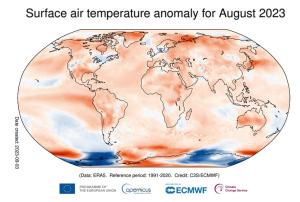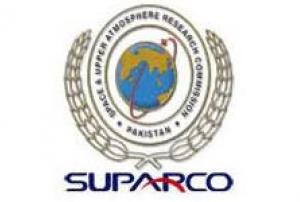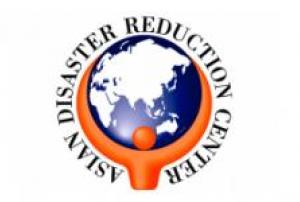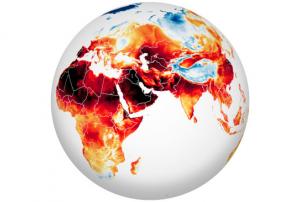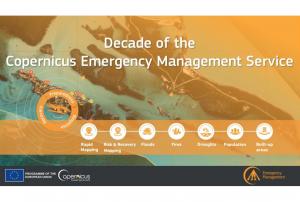Extreme Temperature
Definition
Facts and figures
Further information
UN-SPIDER Regional Support Offices with hazard-specific expertise
Related content on the Knowledge Portal
Heatwaves, which can last for several days, impact societies and their livelihoods in many regions of the world. In August of the year 2003, a severe heatwave impacted Europe. According to the Meteorological Office of the United Kingdom (UK MetOffice), this particular heatwave was the worst one in the last 500 years (https://www.metoffice.gov.uk/weather/learn-about/weather/case-studies/heatwave). This summer heat wave in Europe, unfortunately, affected the elderly more severely, displaying their higher differential vulnerability with respect to people of younger age. In its 64th Newsletter published in September 2021, the Centre for Research on the Epidemiology of Disasters (CRED) of the Catholic University of Louvain (UCLouvain) noted that there were more than 72,000 people killed in Europe. The CRED report, focusing on extreme weather events in Europe, indicated that this heatwave…
read more07/09/2023The Space and Upper Atmosphere Research Commission (SUPARCO) of Pakistan and the United Nations Office of Outer space Affairs (UNOOSA) signed the cooperation agreement on the establishment of a UN-SPIDER Regional Support Office (RSO) on the occasion of the 47th Scientific and Technical Subcommittee sessions on 12 February 2010.
SUPARCO, the national space agency, was established in 1961 as a Committee and was granted the status of a Commission in 1981. SUPARCO is mandated to conduct R&D in space science, space technology, and their peaceful applications in the country. It works towards developing indigenous capabilities in space technology and promoting space applications for socio-economic uplift of the country.
Address:
Pakistan Space and Upper Atmosphere Research Commission (SUPARCO)
Islamabad Highway,
Islamabad-44000 PakistanMission/Objective:
To…
read moreLe Centre Asiatique pour la Prévention des Catastrophes (ADRC) et le Bureau des Affaires Spatiales des Nations Unies (UNOOSA) ont signé l'accord de coopération sur l'établissement du Bureau Régional d'Appui (BRA) ONU-SPIDER de l'ADRC à l'occasion de la 52ème session du Comité des Utilisations Pacifiques de l'Espace Extérieur (COPUOS) le 4 juin 2009.
El Centro Asiático para la Reducción de Desastres (ADRC) y la Oficina de Asuntos del Espacio Ultraterrestre de las Naciones Unidas (UNOOSA) firmaron el 4 de Junio de 2009, con ocasión de la 52ª sesión de la Comisión sobre la Utilización del Espacio Ultraterrestre con Fines Pacíficos (COPUOS), el acuerdo de cooperación para el establecimiento de la Oficina Regional de Apoyo (RSO) de ADRC UN-SPIDER.
In June and July 2022, heatwaves struck Europe, North Africa, the Middle East, and Asia, as temperatures climbed above 40 degrees Celsius (104 degrees Fahrenheit) in places and broke many long-standing records.
The map above shows the surface air temperatures across most of the Eastern Hemisphere on July 13, 2022. It was produced by combining observations with a version of the Goddard Earth Observing System (GEOS) global model, which uses mathematical equations to represent physical processes in the atmosphere.
“While there is a clear pattern of an ‘atmospheric wave’ with alternating warm (redder) and cool (bluer) values in different locations, this large area of extreme (and record breaking) heat is another clear indicator that emissions of greenhouse gases by human activity are causing weather extremes that impact our living conditions,” said Steven…
read more18/07/2022Implementing science to save lives: A Decade of the Copernicus Emergency Management Service
The Copernicus Emergency Management Service (CEMS) celebrates a decade of operation as a world leader in emergency mapping, early warning tools and open-access disaster information.
For the past ten years, CEMS has provided a global service as a fully operation emergency mapping service at no cost to users and with open access data.
Some highlights on the contribution of CEMS in global disaster risk management activities:
- 576 Rapid Mapping Activations with 5,500+ maps delivered
- Designed and implemented the world’s first Global Flood Monitoring tool
- Ten years of wildfire forecasts up to ten days into the future
- Average of 200+ flood and 500+ flash flood notifications to Member States and authorised users each year
- Offers a current and historical database of 7,000+ drought episodes since 1950
…
read more22/06/2022

